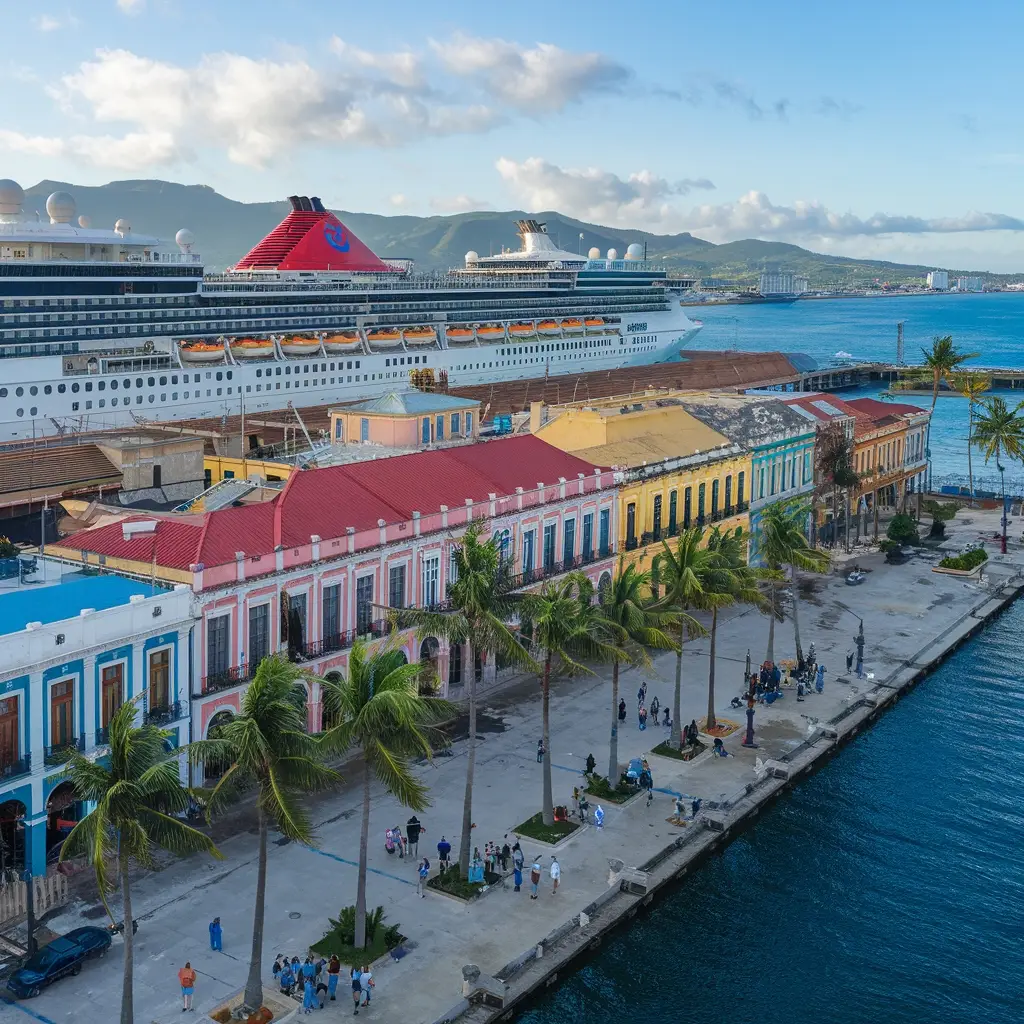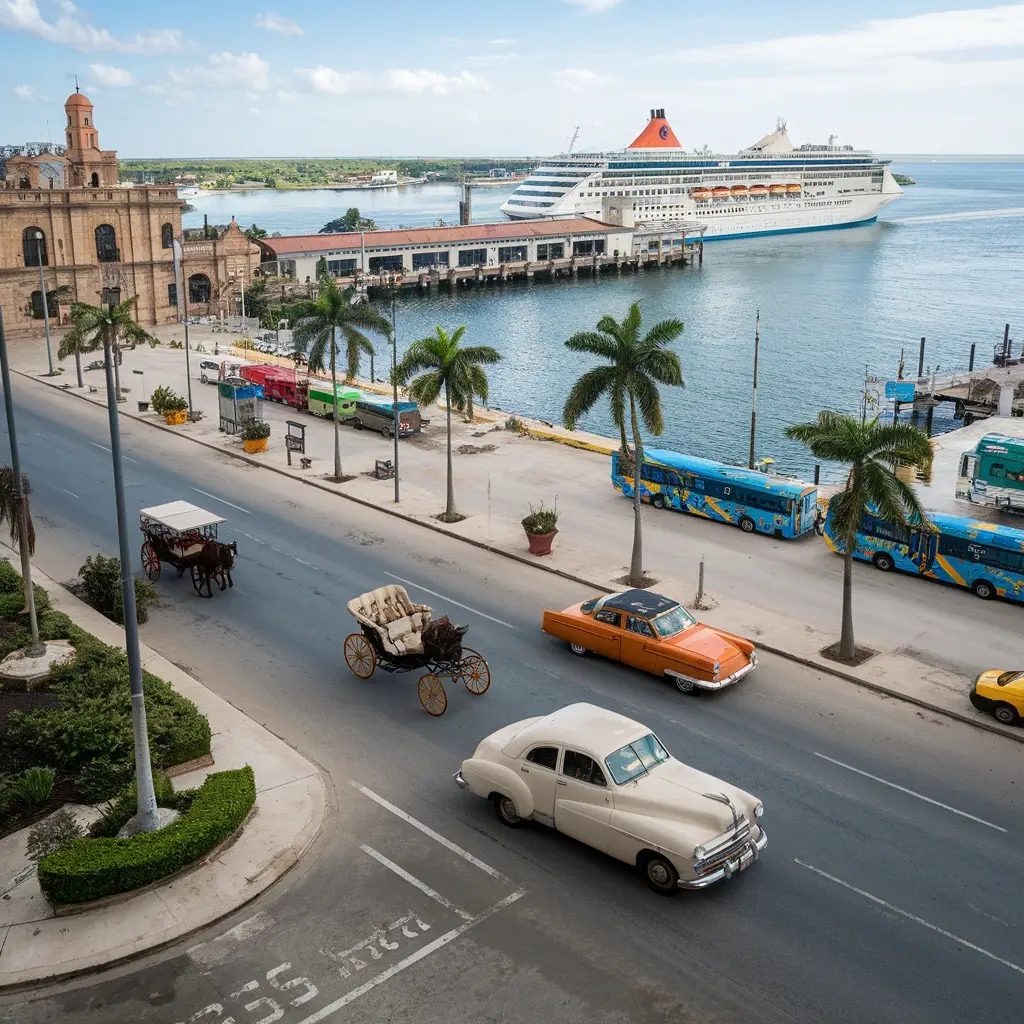You’ll need Cuban convertible pesos (CUC) and your ship ID to explore Santiago de Cuba, the country’s second-largest city.
For other Greater Antilles cruise destinations check out our Greater Antilles Cruise Ship Ports Guide page.
The port offers two must-see attractions: the UNESCO World Heritage site San Pedro de la Roca Castle and the historic Céspedes Park.
Getting around is straightforward – you can choose between three transport options:
- Cocotaxis (bright yellow motorised vehicles)
- Horse-drawn carriages
- Walking tours
Essential items for your visit:
- Comfortable walking shoes
- Sun cream and hat
- Basic Spanish phrases list
The city’s cobblestone streets and colonial architecture make it easy to explore on foot.
You’ll find locals welcoming and the atmosphere relaxed, typical of Caribbean port cities.
Map of Santiago de Cuba, Cuba Cruise Ship Port
Essential Tips for Cruise Passengers in Santiago De Cuba

Getting Ready for Santiago de Cuba From Your Cruise
You need these essentials:
- Cuban convertible pesos (CUC)
- Valid passport
- Cruise ship ID card
- Comfortable walking shoes
- Sun protection (hat, sunscreen)
- Water bottle
- Basic Spanish phrases
Money and Documents:
You can’t rely on credit cards in most places, so bring cash. Keep your passport and ship ID safe – you’ll need both to return to your ship.
Walking the City:
Your feet will thank you for sturdy shoes. The old town has many cobblestones and hills to navigate.
Weather Protection:
You’ll face strong Caribbean sun, so protect yourself. Apply sunscreen regularly and stay hydrated.
Language Tips:
You’ll find locals warm up to you when you try simple Spanish phrases. Even basic greetings help.
Safety and Exploration:
You can discover the city’s culture best through guided tours. These offer a secure way to experience local music, history and traditions.
Top Historical Sites and Cultural Attractions
The five key historical sites in Santiago de Cuba tell powerful stories of the city’s past. You’ll discover San Pedro de la Roca Castle, a UNESCO site with its impressive pirate defence system. The city centre features Céspedes Park, where you can admire the grand Nuestra Señora de la Asunción Cathedral. The Moncada Barracks marks the birthplace of the Cuban Revolution, where you can see bullet holes from Castro’s first attack. You can step back in time at Casa de Diego Velázquez, the oldest house in Cuba, with its colonial architecture and period furnishings. At Santa Ifigenia Cemetery, you’ll find the final resting places of Cuban heroes José Martí and Fidel Castro, marked by striking monuments.
See what’s on offer from the Port of Havana, Cuba for a different Greater Antilles cruise destination.
Getting Around and Local Transportation Options

Getting Around Santiago de Cuba
You can choose from these reliable transport options to explore the city:
Cocotaxis
- Three-wheeled yellow taxis
- Best for short city trips
- Easy to find at main squares
- Cost-effective for 1-2 passengers
Horse Carriages
- Traditional transport option
- Offers scenic city views
- Runs on set routes
- Suits leisurely sightseeing
Local Buses (Guaguas)
- Most economical choice
- Connects major city areas
- Runs on regular schedules
- Used mainly by locals
Walking
- Perfect for the city centre
- Lets you explore narrow streets
- Free and flexible
- Ideal for photography
Travel Tips:
- Agree on fares before your journey
- Share rides to split costs
- Keep small change ready
- Ask your hotel for current rates
Frequently Asked Questions
What Is the Best Time of Year to Visit Santiago De Cuba?
The best time to visit Santiago de Cuba is from November to April. You’ll enjoy dry, mild weather with low humidity during these months. You can explore the city streets comfortably and take part in local festivals. The cooler temperatures make walking tours and outdoor activities more pleasant.
Are US Dollars Widely Accepted in Santiago De Cuba?
US dollars aren’t widely accepted in Santiago de Cuba, so you’ll need to exchange your money. You can use two main currencies: Cuban Pesos (CUP) or Cuban Convertible Pesos (CUC). You should exchange your dollars at official banks or exchange offices to get the best rates and avoid issues. Many shops, restaurants and local services will only take these Cuban currencies, not US dollars.
What Traditional Cuban Dishes Should I Try in Santiago De Cuba?
Try these classic Cuban dishes in Santiago:
- Ropa vieja: A flavourful shredded beef stew in tomato sauce
- Moros y cristianos: A hearty mix of black beans and white rice
- Fried plantains: Sweet, crispy banana-like fruits served as a side dish
- Cuban tamales: Ground corn dough with pork, wrapped in corn husks
You’ll find these dishes at most local restaurants and family-run paladares throughout Santiago. Each dish represents authentic Cuban home cooking and uses local ingredients.
Is Tap Water Safe to Drink in Santiago De Cuba?
Tap water in Santiago de Cuba isn’t safe for visitors to drink. You should drink bottled water throughout your stay to protect your health. Skip drinks with ice cubes, just like the local residents do. This simple precaution helps you avoid stomach upsets and keeps you hydrated safely during your visit.
What Local Festivals or Events Are Celebrated in Santiago De Cuba?
Santiago de Cuba hosts three major festivals you can experience throughout the year:
The Festival del Caribe runs each July, where you can enjoy Caribbean music, dance and cultural displays.
The Festival de la Trova happens in March, letting you discover traditional Cuban folk music performances.
The Carnaval takes place in summer, offering you street parades, traditional dancing and local music celebrations.
Each festival gives you a chance to join locals in authentic Cuban celebrations and traditions.
Thinking about something different? Check out the cruises leaving from Cienfuegos, Cuba Cruise Ship Port.
